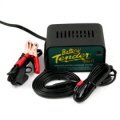Googling found this. Looks from
here like you should utilize the CCA number.
Personally here have one larger charger that has one low and one high amp charge and a few of the smaller chargers which utilize 1 or 2 amps that I utilize to trickle charge.
CCA, CA, AH and RC. What are these all about?
These are the standards that most battery companies use to rate the output and capacity of a battery.
Cold cranking amps
(CCA) is a measurement of the number of amps a battery can deliver at 0 ° F for 30 seconds and not drop below 7.2 volts. So a high CCA battery rating is especially important in starting battery applications, and in cold weather.This measurement is not particularly important in Deep cycle batteries,
though it is the most commonly 'known' battery measurement.
CA is cranking amps measured at 32 degrees F. This rating is also called marine cranking amps
(MCA). Hot cranking
amps (HCA) is seldom used any longer but is measured at 80 ° F.
Reserve Capacity
(RC) is a very important rating. This is the number of minutes a fully charged battery at 80 ° F will discharge 25 amps until the battery drops below 10.5 volts.
An amp hour
(AH) is a rating usually found on deep cycle batteries. The standard rating is an Amp rating taken for 20 Hours. What this means, say for a 100 AH rated battery is this: Draw from the battery for 20 hours and it will provide a total of 100 amp-hours. That translates to about 5 amps an hour. 5 x 20 = 100. However, it's very important to know that the total time of discharge and load applied is not a linear relationship. As your load increases, your realized capacity decreases. This means if you discharged that same 100 AH battery by a 100 amp load, it
will not give you one hour of runtime. On the contrary, the perceived capacity of the battery will be that of 64 Amp Hours.
If the current drawn is x amps, the time is T hours then the capacity C in amp-hours is
C = xT
For example, if your pump is drawing 120 mA and you want it to run for 24 hours
C = 0.12 Amps * 24 hours = 2.88 amp hours
Cycle life considerations
C’ = C/0.8
Using first example
C’ = 2.88 AH / 0.8 = 3.6 AH
Here went to Black and Decker trickle chargers and keep them at 1 AMP. 2 cars have batteries sort of hidden in the trunk with posts going to the front. They came with wiring kits (quick disconnects).

